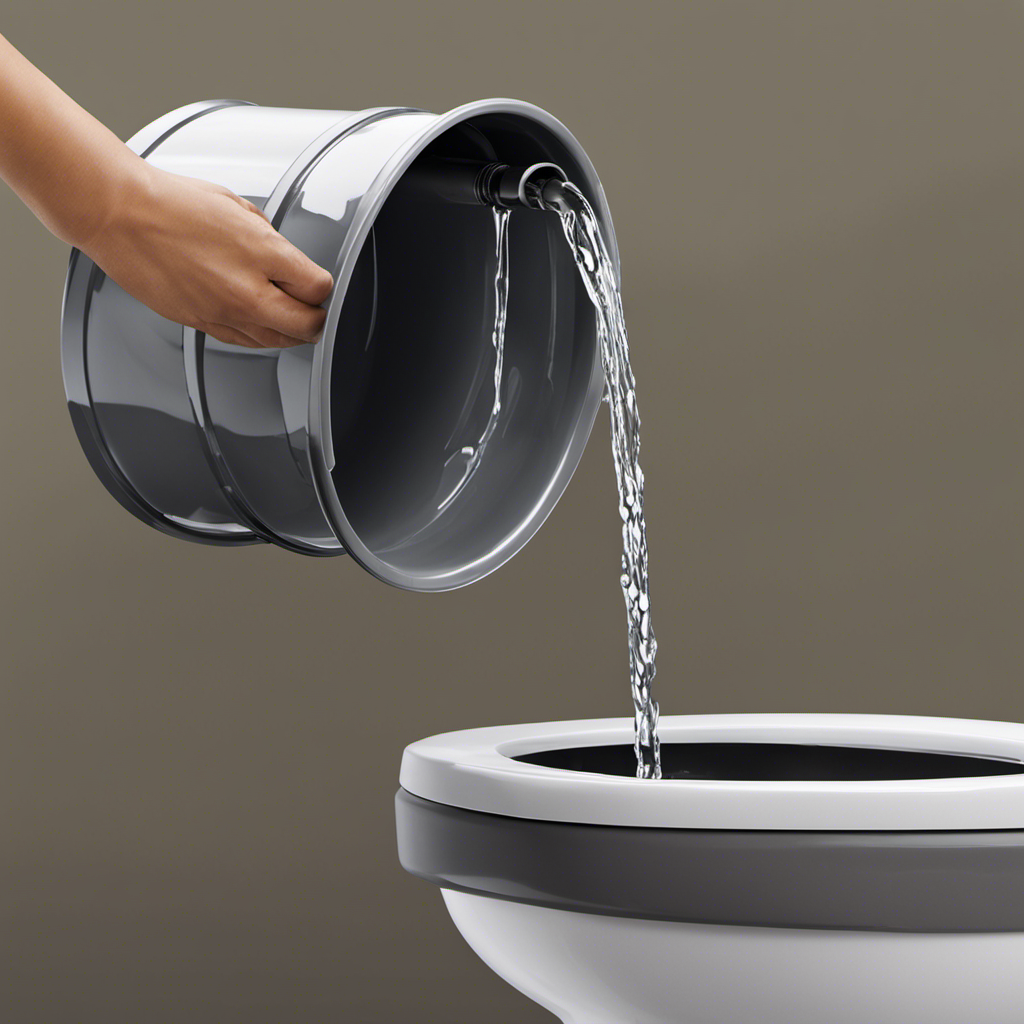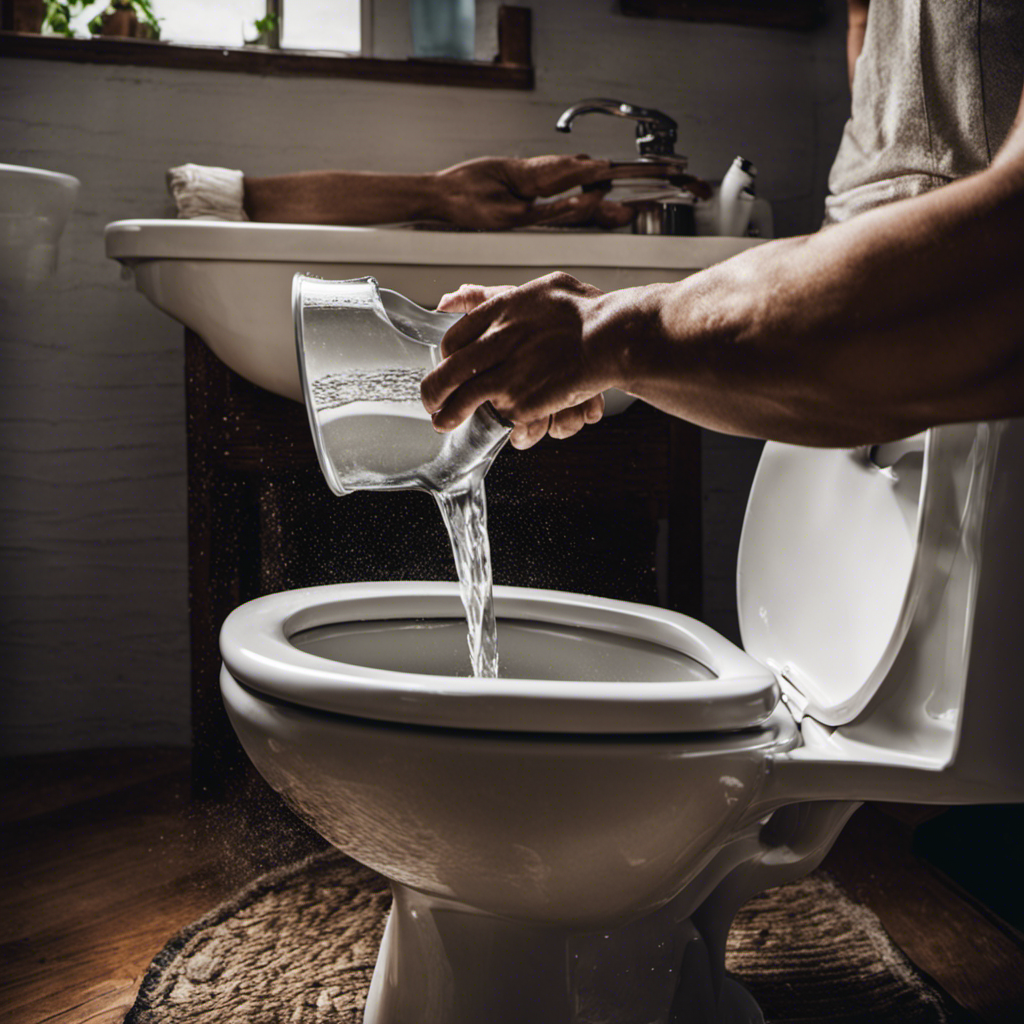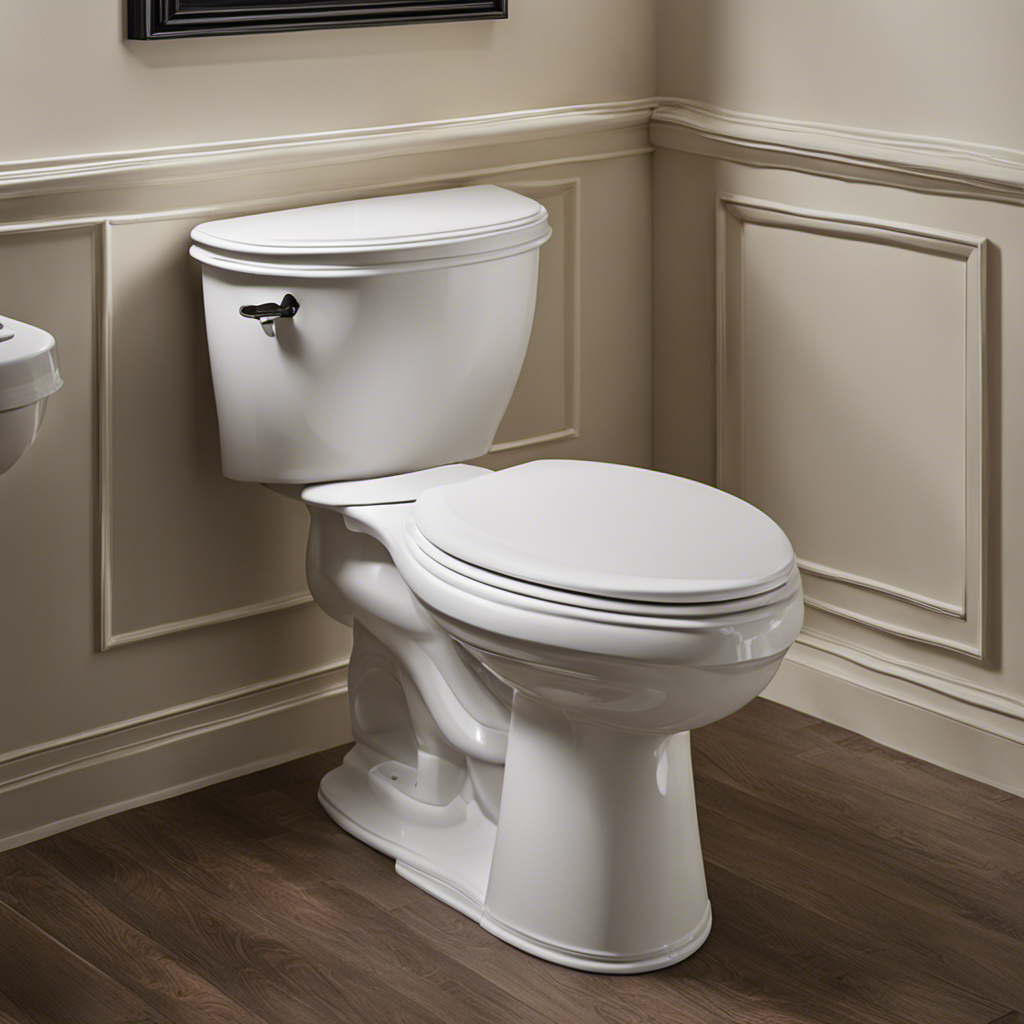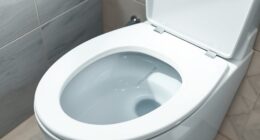In a world where running water is not always readily available, knowing how to flush a toilet without it becomes essential.
Fortunately, there are two efficient methods that can be employed.
The first method involves pouring water into the toilet tank, while the second method requires pouring water directly into the toilet bowl.
By utilizing these techniques, individuals can effectively flush their toilets using alternative water sources.
This article explores these methods in detail, providing tips and techniques for successful flushing without running water.
Key Takeaways
- The toilet can be flushed at least once when the water is shut off.
- There are two methods to flush a toilet without running water: pouring water into the toilet tank or pouring water directly into the toilet bowl.
- Method 1: Fill a 2 to 5-gallon bucket with cold water and pour it into the tank until it reaches about half an inch beneath the overflow tube.
- Method 2: Lift the toilet seat, pour a fourth of the water into the bowl, and then pour the remaining water in more quickly to create enough water pressure for flushing.
The Basics of Flushing a Toilet Without Running Water
The toilet can be flushed at least once when the water is shut off, as the tank will already be filled with water from the previous use. However, after the first flush, the toilet tank and bowl will no longer fill up with water.
In order to flush the toilet without running water, alternative methods must be employed. There are two main methods to consider.
The first method involves pouring water into the toilet tank to initiate the flush. Water can be gathered from nearby sources such as neighbors, drinking water containers, or natural water resources. A 2 to 5-gallon bucket filled with cold water can be used for this purpose. The water should be poured into the tank until it reaches about half an inch beneath the overflow tube. The toilet can then be flushed by pressing the lever or flush button.
The second method involves pouring water directly into the toilet bowl to initiate the flush mechanism. Again, a 2 to 5-gallon bucket filled with water can be used for this method. The toilet seat should be lifted to avoid splashing waste onto it. About a fourth of the water should be poured into the bowl slowly, taking care not to splash. The remaining water should be poured more quickly to create enough water pressure for flushing. It is important to keep a plunger nearby and watch for any clogs during the flushing process.
These alternative flushing methods can be useful in emergency situations where running water is not available, and they can help conserve water as well.
Method 1: Flushing by Pouring Water Into the Toilet Tank
To initiate the flush mechanism, water can be poured directly into the toilet tank using Method 1. This method is a reliable option for flushing a toilet without running water.
When faced with a water shortage or shut-off, it is crucial to have alternative solutions to maintain proper sanitation. By gathering water from nearby sources such as neighbors or using drinking water containers, you can fill a 2 to 5-gallon bucket with cold water.
Then, carefully pour the water into the toilet tank until it reaches about half an inch beneath the overflow tube. Finally, simply press the lever or flush button to initiate the flush.
This method not only provides a temporary solution for toilet flushing but also contributes to water-saving efforts and promotes sustainable practices.
Method 2: Flushing by Pouring Water Into the Toilet Bowl
Pouring water directly into the toilet bowl is another effective method for initiating the flush mechanism when faced with a water shortage or shut-off. This alternative flushing method can be useful in situations where the water supply is temporarily unavailable or when troubleshooting common toilet flushing issues. Here are some key points to consider:
- Method 2: Flushing by Pouring Water Into the Toilet Bowl
- Use a 2 to 5-gallon bucket filled with cold water (or hot water for potential clogs).
- Lift the toilet seat to avoid splashing waste onto it.
- Slowly pour about a fourth of the water into the bowl, being cautious about splashing.
- Pour the remaining water more quickly to create enough water pressure for flushing.
- Watch the toilet as it flushes to check for any clogs and keep a plunger nearby.
Gathering Water for Flushing From Nearby Sources
Using nearby sources, such as neighbors or natural water resources, one can gather water for flushing the toilet. Collecting water from alternative sources is a practical solution when faced with a lack of running water.
In Method 1, one can fill a 2 to 5-gallon bucket with cold water and pour it into the toilet tank to initiate the flush. This water can be obtained from nearby drinking water containers or even natural water resources, if available. It is important to ensure that the water level in the tank reaches about half an inch beneath the overflow tube to ensure a proper flush.
Tips and Techniques for Flushing Without Running Water
When faced with a lack of running water, individuals can gather water from nearby sources to maintain proper sanitation. In emergency situations where running water is unavailable, it is important to know alternative options for flushing a toilet. Here are some tips and techniques for flushing without running water:
- Method 1: Pour water into the toilet tank to flush it.
- Method 2: Pour water directly into the toilet bowl to initiate the flush mechanism.
Gather water from nearby sources like neighbors, drinking water containers, or natural water resources. Fill a 2 to 5-gallon bucket with cold water and pour it into the tank until it reaches about half an inch beneath the overflow tube. Lift the toilet seat, pour a fourth of the water into the bowl, and then pour the remaining water in more quickly to create enough water pressure for flushing.
These methods can be used in emergency situations when running water is not available, providing an effective way to maintain proper sanitation.
Water Consumption and Efficiency in Toilet Flushing
Most modern toilets now require significantly less water per flush compared to older models. These water-saving techniques have a positive environmental impact by reducing water consumption and promoting water conservation.
In the past, toilets would use several gallons of water just to flush. However, advancements in toilet design have led to toilets that only require about a gallon and a half of water to flush completely. This significant decrease in water usage not only helps conserve water but also reduces water bills for households.
Additionally, upgrading to a water-efficient toilet can further reduce water consumption. By implementing these water-saving techniques and using water-efficient toilets, individuals can play their part in protecting the environment and promoting sustainable water management.
Upgrading to Water-Efficient Toilets for Better Resource Conservation
Upgrading to water-efficient toilets significantly reduces water consumption and promotes resource conservation. It is a smart choice for both homeowners and the environment. Here are five reasons why upgrading to water-efficient toilets is beneficial:
-
Reduced water consumption: Water-efficient toilets use less water per flush, typically around 1.28 gallons or less, compared to older toilets that can use up to 3 or more gallons. This significantly reduces water usage and helps conserve this precious resource.
-
Cost savings: By using less water, upgrading to water-efficient toilets can lead to lower water bills. Over time, the savings can add up and offset the initial upgrading costs.
-
Environmental impact: By reducing water consumption, water-efficient toilets help conserve water resources and contribute to environmental sustainability. This is especially important in areas experiencing water scarcity or drought conditions.
-
Improved performance: Water-efficient toilets are designed to provide efficient and effective flushing, ensuring that waste is properly removed with each flush. They are engineered to meet industry standards for performance while using less water.
-
Long-term investment: Upgrading to water-efficient toilets is a long-term investment in your home. Not only does it contribute to water conservation, but it can also increase the value of your property and appeal to potential buyers in the future.
Frequently Asked Questions
Can I Use Hot Water Instead of Cold Water to Flush the Toilet Without Running Water?
Using hot water instead of cold water to flush a toilet without running water is possible. However, caution is needed to avoid potential damage to the toilet. Alternative methods can provide benefits such as increased water pressure for flushing.
How Often Do I Need to Flush the Toilet Manually When the Water Is Shut Off?
When the water is shut off, the toilet needs to be manually flushed. The frequency of manual flushing depends on usage, but generally, it needs to be done after each use. Methods include pouring water into the tank or bowl.
Are There Any Potential Risks or Problems Associated With Flushing the Toilet Without Running Water?
There are potential risks and problems associated with flushing a toilet without running water. These include the possibility of clogs, insufficient water pressure, and the need for manual intervention to ensure proper flushing.
Can I Use Any Type of Container to Gather Water for Flushing, or Are There Specific Recommendations?
Yes, any container can be used to gather water for flushing. However, it is recommended to use clean containers that can hold at least 2 to 5 gallons of water.
What Are Some Alternative Methods for Flushing the Toilet Without Running Water if I Don’t Have Access to Nearby Water Sources?
Alternative methods for flushing the toilet without running water include pouring water into the tank or directly into the bowl. These methods can be efficient if done correctly, using enough water pressure to initiate a flush.
Conclusion
In conclusion, flushing a toilet without running water can be easily achieved by following the two methods discussed.
Method 1 involves pouring water into the toilet tank, while Method 2 requires pouring water directly into the toilet bowl.
By utilizing nearby water sources and being mindful of water consumption, individuals can effectively conserve water and reduce their bills.
Upgrading to water-efficient toilets can further enhance resource conservation.
So, whether you’re facing a water shortage or simply want to be more eco-friendly, these techniques provide efficient solutions to maintain proper sanitation.










